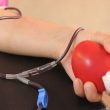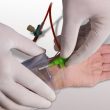Courtesy of Dr. Carlos Fava. One of the characteristics of chronic total occlusion (CTO) is the use of two access routes: femoral and radial. The radial approach is safer, but it has not been thoroughly analyzed in this type of PCI. The study looked at 3709 patients undergoing left main percutaneous coronary intervention (PCI) for...
Radial Access Is Always Preferred, Even for Treatment of the Left Main Coronary Artery
The potential need for a 7-Fr guidewire, the use of several coronary guidewires and/or a kissing balloon, and the requirement of indispensable monitoring by intravascular ultrasound (IVUS) have been used by some interventional cardiologists as excuses to resist radial access. In that sense, left main coronary artery angioplasty was the last stand of femoral access....
Less Bivalirudin and Minimal Use of Ultrasound for Puncture Is the Worldwide Trend in Transradial Access
A worldwide survey shows there is much room for improvement as regards transradial access procedures, particularly for the prevention of radial artery occlusion post-procedure. While in many places this has been a standard technique for some time now, other places are yet to evolve, and that is the result of this survey. In the past...
A Simple Trick to Improve Our Transradial Punctures
Transradial access is here to stay; that much has been clear for some time now. However, some operators still resist change and the systematic use of this technique shows great geographical dispersion. Some of its limitations are a difficulty to obtain access and the somewhat frequent occurrence of radial artery occlusion after the procedure. This...
SOLACI-SOCIME 2018 | Acceso Vascular por Vía Radial. Slender Devices
Read articles on the main presentations of the first day of SOLACI-SOCIME 2018 Congress. See the presentation by Dr. José Luis Leiva Pons, entitled “Acceso Vascular por Vía Radial. Slender Devices”. We are interested in your opinion. Please, leave your comments, thoughts, questions, etc., below. They will be most welcome.
ESC 2018 | MATRIX: 1-Year Superiority of Transradial Access
Transradial access should be the access of choice in patients with acute coronary syndrome, while bivalirudin has not shown any benefit for this population. The long-term follow-up from the MATRIX (Minimizing Adverse Hemorrhagic Events by Transradial Access Site and Systemic Implementation of Angiox) trial confirms the results at 30 days: transradial access is here to stay...
Manual vs. Mechanical Compression after Transradial Catheterization
For patients undergoing transradial catheterization, whether puncture site compression is manual or mechanical has no significant difference as regards post procedural radial artery occlusion (RAO) rate. Hemostasis is shorter with manual compression, but it seems difficult to implement in the clinical practice. We could carry out an economical sub-analyzis of this study to find out...
EuroPCR 2018 | LeDRA: Left Distal Radial Approach for angiography and angioplasty
The left distal radial artery has been recently proposed as an alternative in selected patients with high success rate and low complications rate. This study evaluated the feasibility and safety of this puncture both for coronary angiography and angioplasty. It included 200 consecutive patients with palpable left distal radial artery punctured by three expert operators....
Tips to Prevent Radial Occlusion after Catheterization
The transradial access is the preferred access site for patients undergoing acute coronary syndrome. Compared to the transfemoral access site, it reduces the risk of all cause death, vascular complications and major bleeding. Radial artery occlusion is the most frequent vascular complication associated to this approach, though it rarely results in clinical consequences such as ischemia, given the...
Important Study Suggests that Rotational Atherectomy Is Feasible with Transradial Access
Rotational atherectomy is a very important tool in the treatment of heavily calcified and non-dilatable lesions. Historically, transfemoral access has been the gold standard due to a perceived need for large-bore guidewire catheters in order to use spheroids for proper debulking. Nowadays, rotational atherectomy has evolved towards a technique that aims to modify plaque for...





